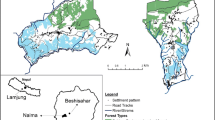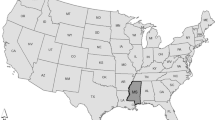Abstract
Deforestation in Nepal threatens the functioning of complex social–ecological systems, including rural populations that depend on forests for subsistence, as well as Nepal’s biodiversity and other ecosystem services. Nepal’s forests are particularly important to the nation’s poorest inhabitants, as many depend upon them for daily survival. Two-thirds of Nepal’s population relies on forests for sustenance, and these pressures are likely to increase in the future. This, coupled with high population densities and growth rates, highlights the importance of studying the relationship between human communities, forest cover trends through time, and forest management institutions. Here, we used surveys to explore how household attitudes associated with conservation-related behaviors in two rural communities—one that has experienced significant forest loss, and the other forest gain—compare with forest cover trends as indicated by satellite-derived forest-loss and -regeneration estimates between 2005 and 2013. Results found a significant difference in attitudes in the two areas, perhaps contributing to and reacting from current forest conditions. In both study sites, participation in community forestry strengthened support for conservation, forest conservation-related attitudes aligned with forest cover trends, and a negative relationship was found between economic status and having supportive forest conservation-related attitudes. In addition, on average, respondents were not satisfied with their district forest officers and did not feel that the current political climate in Nepal supported sustainable forestry. These findings are important as Nepal’s Master Plan for the Forestry Sector has expired and the country is in the process of structuring a new Forestry Sector Strategy.

Similar content being viewed by others
Notes
For more information about SeedTree, visit: http://www.seedtree.org/.
References
Acharya U, Petheram RJ, Reid R (2004) Concepts and perceptions of biodiversity in community forestry, Nepal. Small Scale For Econ Manag Policy 3:401–410. doi:10.1007/s11842-004-0028-8
Adhikari B, Di Falco S, Lovett JC (2004) Household characteristics and forest dependency: evidence from common property forest management in Nepal. Ecol Econ 48:245–257. doi:10.1016/j.ecolecon.2003.08.008
Agrawal A, Gupta K (2005) Decentralization and participation: the governance of common pool resources in Nepal’s Terai. World Dev 33:1101–1114. doi:10.1016/j.worlddev.2005.04.009
Agrawal A, Ostrom E (2001) Collective action, property rights, and decentralization in resource use in India and Nepal. Polit Soc 29(4):485–514. doi:10.1177/0032329201029004002
Agrawal A, Ostrom E (2008) Decentralization and community-based forestry: learning from experience. In: Webb EL, Shivakoti GP (eds) Decentralization, forests and rural communities: policy outcomes in Southeast Asia. Sage Publications, New Delhi, pp 44–67
Agrawal A, Ribot JC (1999) Accountability in decentralization: a framework with South Asian and West African cases. J Dev Areas 33:473–502
Andersson KP, Ostrom E (2008) Analyzing decentralized resource regimes from a polycentric perspective. Policy Sci 41:71–93. doi:10.1007/s11077-007-9055-6
Arnold JEM (1992) Community forestry ten years in review. FAO, Rome
Banskota K, Sharma B, Sharma U, Rijal A (1996) Royal Chitwan National Park after twenty years: an assessment of values, threats, and opportunities. King Mahendra Trust for Nature Conservation, Kathmandu
Barber JS, Shivakoti GP, Axinn WG, Gajurel K (1997) Sampling strategies for rural settings: a detailed example from Chitwan Valley Family Study, Nepal. Nepal Popul J 6:193–203
Benoit C, Jansson M, Millar A, Phillips R (2005) Community-academic research on hard-to-reach populations: benefits and challenges. Qual Health Res 15:263–282. doi:10.1177/1049732304267752
Bernard RH (2002) Research methods in anthropology: qualitative and quantitative methods, 3rd edn. AltaMira Press, Walnut Creek
Birendra KC, Stainback GA, Chhetri BBK (2014) Community users’ and experts’ perspective on community forestry in Nepal: a SWOT–AHP analysis. For Trees Livelihoods 23:217–231. doi:10.1080/14728028.2014.929982
Bista DB (1987) People of Nepal, 5th edn. Ratna Pustak Bhandar, Kathmandu
Chakraborty RN (2001) Stability and outcomes of common property institutions in forestry: evidence from the Terai region of Nepal. Ecol Econ 36:341–353. doi:10.1016/S0921-8009(00)00237-8
Chevan A, Sutherland M (1991) Hierarchical partitioning. Am Stat 45:90–96
Chhetri BBK, Lund JF, Nielsen ØJ (2012) The public finance potential of community forestry in Nepal. Ecol Econ 73:113–121. doi:10.1016/j.ecolecon.2011.09.023
Cohen JM, Uphoff NT (1980) Participation’s place in rural development: seeking clarity through specificity. World Dev 8:213–235. doi:10.1016/0305-750X(80)90011-X
De Vaus D (2002) Surveys in social research, 5th edn. Routledge, London
DeVellis RF (1991) Scale development: theory and applications. Sage, Newbury Park
Food and Agricultural Organization of the United Nations (FAO) (2003) Compendium of agricultural–environmental indicators: 1989–91 to 2000. FAO, Rome, p 36
Gautam AP (2007) Group size, heterogeneity and collective action outcomes: evidence from community forestry in Nepal. Int J Sustain Dev World Ecol 14:574–583. doi:10.1080/13504500709469756
Gautam AP (2009) Equity and livelihoods in Nepal’s community forestry. Int J Soc For 2:101–122
Gautam AP, Shivakoti GP (2005) Conditions for successful local collective action in forestry: some evidence from the Hills of Nepal. Soc Nat Resour 18:153–171. doi:10.1080/08941920590894534
Gautam AP, Shivakoti GP, Webb EL (2004) A review of forest policies, institutions, and changes in the resource condition in Nepal. Int For Rev 6:136–148. doi:10.1505/ifor.6.2.136.38397
Government of Nepal (GoN) (2011) National population and housing census. GoN, Kathmandu
Government of Nepal (GoN) (2014) Review of implementation of the Master Plan for the Forestry Sector: achievements and lessons. GoN, Kathmandu
Gurung A, Bista R, Karki R et al (2013) Community-based forest management and its role in improving forest conditions in Nepal. Small Scale For 12:377–388. doi:10.1007/s11842-012-9217-z
His Majesty’s Government of Nepal (HMGN) (1991) National population and housing census. HMGN, Kathmandu
His Majesty’s Government of Nepal (HMGN) (1993) Forest Act 1993. HMGN, Kathmandu
His Majesty’s Government of Nepal (HMGN) (1995) Forest Regulations 1995. HMGN, Kathmandu
His Majesty’s Government of Nepal (HMGN) (2001) National population and housing census. HMGN, Kathmandu
His Majesty’s Government of Nepal (HMGN), Asian Development Bank (ADB), Finnish International Development Agency (FINNIDA) (1988) Master Plan for the Forestry Sector Nepal: main report. HMGN, ADB, FINNIDA, Kathmandu
Iversen V, Chhetry B, Francis P et al (2006) High value forests, hidden economies and elite capture: evidence from forest user groups in Nepal’s Terai. Ecol Econ 58:93–107. doi:10.1016/j.ecolecon.2005.05.021
Jones S (2007) Tigers, trees and Tharu: an analysis of community forestry in the buffer zone of the Royal Chitwan National Park, Nepal. Geoforum 38:558–575. doi:10.1016/j.geoforum.2006.10.010
Karanth KK, Nepal SK (2012) Local residents perception of benefits and losses from protected areas in India and Nepal. Environ Manag 49:372–386. doi:10.1007/s00267-011-9778-1
Khadka M (2010) Why does exclusion continue in Nepal’s community forestry? Aid, knowledge and power in forest policy process. Lambert Academic Publishing, Saarbrücken
Khadka M, Karki S, Karky BS et al (2014) Gender equality challenges to the REDD+ initiative in Nepal. Mt Res Dev 34:197–207. doi:10.1659/MRD-JOURNAL-D-13-00081.1
Kish L (1965) Survey sampling. Wiley, New York
Lund JF, Baral K, Bhandari NS et al (2014) Who benefits from taxation of forest products in Nepal’s community forests? For Policy Econ 38:119–125. doi:10.1016/j.forpol.2013.04.010
Lyon F (2000) Trust, networks and norms: the creation of social capital in agricultural economies in Ghana. World Dev 28:663–681. doi:10.1016/S0305-750X(99)00146-1
Mac Nally R (2002) Multiple regression and inference in ecology and conservation biology: further comments on identifying important predictor variables. Biodivers Conserv 11:1397–1401. doi:10.1023/A:1016250716679
Mahat I (2009) Doing fieldwork in development research: issues in applications of methodologies. In: Mahat I (ed) Gender and rural energy technologies in Nepal: planning and policy perspectives. VDM Publishing, Saarbrücken, p 400
Malla YB, Neupane HR, Branney PJ (2003) Why aren’t poor people benefiting more from community forestry? J For Livelihood 3:78–92
McDougall CL, Leeuwis C, Bhattarai T et al (2013) Engaging women and the poor: adaptive collaborative governance of community forests in Nepal. Agric Hum Values 30:569–585. doi:10.1007/s10460-013-9434-x
Mehta JN, Heinen JT (2001) Does community-based conservation shape favorable attitudes among locals? An empirical study from Nepal. Environ Manag 28:165–177. doi:10.1007/s10531-011-9993-3
Mehta JN, Kellert SR (1998) Local attitudes toward community-based conservation policy and programmes in Nepal: a case study in the Makalu–Barun Conservation Area. Environ Conserv 25:320–333. doi:10.1017/S037689299800040X
Moser CA, Kalton G (1971) Survey methods in social investigation, 2nd edn. Heinemann Educational, London
Nagendra H (2007) Drivers of reforestation in human-dominated forests. Proc Natl Acad Sci USA 104:15218–15223. doi:10.1073/pnas.0702319104
Nagendra H, Karmacharya M, Karna B (2005) Evaluating forest management in Nepal: views across space and time. Ecol Soc 10:24
Nepal SK, Spiteri A (2011) Linking livelihoods and conservation: an examination of local residents’ perceived linkages between conservation and livelihood benefits around Nepal’s Chitwan National Park. Environ Manag 47:727–738. doi:10.1007/s00267-011-9631-6
Oppenheim AN (1992) Questionnaire design, interviewing, and attitude measurement. Pinter Publishers, London
Ostrom E (1990) Governing the commons: the evolution of institutions for collective action. Cambridge University Press, New York
Ostrom E, Schroeder LD, Wynne SG (1993) Institutional incentives and sustainable development: infrastructure policies in perspective. Westview Press, Boulder
Pandit R, Bevilacqua E (2011a) Forest users and environmental impacts of community forestry in the hills of Nepal. For Policy Econ 13:345–352. doi:10.1016/j.forpol.2011.03.009
Pandit R, Bevilacqua E (2011b) Social heterogeneity and community forestry processes: reflections from forest users of Dhading District, Nepal. Small Scale For 10:97–113. doi:10.1007/s11842-010-9136-9
Pokharel RK, Tiwari KR, Rayamajhi S (2012) Nepal’s community forestry: need of better governance. In: Okia CA (ed) Global perspectives on sustainable forest management. InTech, Rijeka, Croatia, pp 43–58. http://www.intechopen.com/books/global-perspectives-on-sustainable-forest-management/nepal-scommunity-forestry-need-of-better-governance
Poudel M, Thwaites R, Race D, Dahal RG (2014) REDD+ and community forestry: implications for local communities and forest management—a case study from Nepal. Int For Rev 16:39–54. doi:10.1505/146554814811031251
R Core Team (2014) R: a language and environment for statistical computing. R Core Team, Vienna
Sah JP, Heinen JT (2001) Wetland resource use and conservation attitudes among indigenous and migrant peoples in Ghodaghodi Lake area, Nepal. Environ Conserv 28:345–356. doi:10.1017/S0376892901000376
Sharma P, Guha-Khasnobis B, Raj Khanal D (2014) Nepal human development report 2014. GoN (Government of Nepal) and UNDP (United Nations Development Programme), Kathmandu
Shivakoti GP, Ostrom E (2002) Improving irrigation governance and management in Nepal. ICS Press, Oakland
Shrestha KK, McManus P (2007) The embeddedness of collective action in Nepalese community forestry. Small Scale For 6:273–290. doi:10.1007/s11842-007-9020-4
Spiteri A, Nepal SK (2008) Distributing conservation incentives in the buffer zone of Chitwan National Park, Nepal. Environ Conserv 35:76–86. doi:10.1017/S0376892908004451
Stapp JR, Lilieholm RJ, Upadhaya S, Johnson T (2015) Evaluating the impacts of forest management policies and community-level institutions in the buffer zone of Chitwan National Park, Nepal. J Sustain For 34:445–464. doi:10.1080/10549811.2015.1025080
Stræde S, Treue T (2006) Beyond buffer zone protection: a comparative study of park and buffer zone products’ importance to villagers living inside Royal Chitwan National Park and to villagers living in its buffer zone. J Environ Manag 78:251–267. doi:10.1016/j.jenvman.2005.03.017
Sudman S, Sirken MG, Cowan CD (1988) Sampling rare and elusive populations. Science 240:991–996. doi:10.1126/science.240.4855.991
Tashakkori A, Teddlie C (1998) Mixed methodology: combining qualitative and quantitative approaches. Sage Publications, Inc., Thousand Oaks
Thoms CA (2008) Community control of resources and the challenge of improving local livelihoods: a critical examination of community forestry in Nepal. Geoforum 39:1452–1465. doi:10.1016/j.geoforum.2008.01.006
United Nations Educational Scientific and Cultural Organization (UNESCO) (2013) Chitwan National Park. http://whc.unesco.org/en/list/284. Accessed 1 Oct 2014
Acknowledgments
This research was supported by the National Science Foundation Award EPS-0904155 to Maine EPSCoR Sustainability Solutions Initiative at the University of Maine, McIntire-Stennis Grant Number MEO-M-700510-13, and the USDA National Institute of Food and Agriculture. Additional support was provided by the Maine Agriculture and Forestry Experimental Station (Publication # 3405) and the Center for Research on Sustainable Forests. We thank, for their assistances, Dr. Ambika Gautam of Kathmandu Forestry College, Abdul Ansari of the World Wildlife Fund-Nepal, Carol Kinsey of SeedTree, Baburam Vishowakarma, Satya-Narayan Chaudhary, Yubaraj Ghatane, and Beeju Poudyal.
Author information
Authors and Affiliations
Corresponding author
Rights and permissions
About this article
Cite this article
Stapp, J.R., Lilieholm, R.J., Leahy, J. et al. Linking Attitudes, Policy, and Forest Cover Change in Buffer Zone Communities of Chitwan National Park, Nepal. Environmental Management 57, 1292–1303 (2016). https://doi.org/10.1007/s00267-016-0682-6
Received:
Accepted:
Published:
Issue Date:
DOI: https://doi.org/10.1007/s00267-016-0682-6




